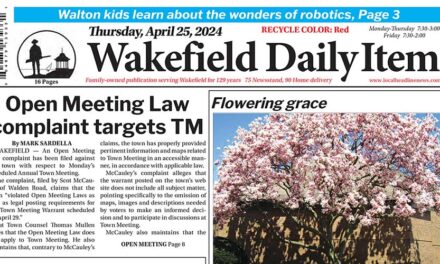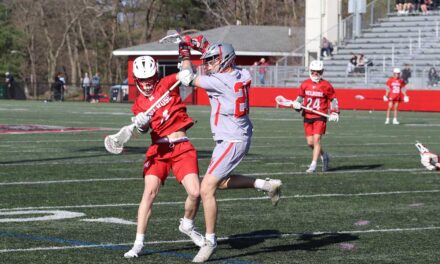By MARK SARDELLA
WAKEFIELD — Every fall for the last several years, the Town Council, the Finance Committee and the School Committee have gotten together to hear and discuss the current state of the town’s finances in advance of the annual budget process, which gets underway in earnest early in the new year.
Last week’s annual “Tri-Board” meeting followed its usual harmonious pattern amid the presentation of numbers, figures and more numbers – until near the end when Town Councilor Edward Dombroski Jr. directed some rather pointed questions to the School Committee and Superintendent Doug Lyons.
This year’s meeting of the town’s top three boards was held virtually via Zoom and carried live on cable and online by WCAT.
The meeting began with an overview of the town’s finances presented by Dan Sherman of the Finance Committee. He said that after a down year in 2020 local receipts came in much better than expected in FY 2021, led by the automobile excise tax. Restaurants also did better than expected, he said, resulting in more revenue from the local option meals tax.
Free Cash also came in higher than expected, Sherman said, and next month’s Regular Town Meeting will be asked to use some of that Free Cash to balance the budget.
Sherman said that while the town would obviously like more, state aid is trending in the right direction.
He said that the town would like to grow the Stabilization Fund and the Debt Service Fund.
Sherman noted that the town had cut capital spending in half during the height of the pandemic, but brought it back to $2 million for the current fiscal year (FY 2022).
FinCom Chairman Jim Sullivan was asked to review the annual budget process, starting in the fall with budget preparations by departments, boards and committees, review by the Town Council and the Finance Committee and ultimately to Annual Town Meeting for a vote in the spring.
Town Administrator Stephen P. Maio broke down elements of the current year’s approximately $100 million-town budget, which he described as “a very healthy number.” He also talked about the town’s budgetary response to COVID.
Maio said that the town would be getting just over $11 million in state aid this year. Local receipts are again looking good, he said.
He also broke down the COVID relief funding received by the town. Of the $2.4 Million in Cares Act funds, $979,000 was spent on school-related needs, $352,000 on pandemic-related capital expenditures, $419,000 went to testing and social distance measures, $555,000 was spent on overtime and salaries along with another $89,000 in miscellaneous spending.
School Superintendent Doug Lyons broke down the $45,343,200 FY 2022 School Department budget, which includes $37,746,618 for personnel.
He discussed the School Department’s COVID-related costs, including eight full-time-equivalent one-year COVID positions totaling $480,000. Those include two new custodians, two new nurses and four new teachers.
He also listed another 4.5 full-time positions funded from the ESSER II federal COVID relief grant, including one adjustment counselor at the high school, one adjustment counselor at the middle school, two school psychologists for middle and high school, and a half-time language-based teacher at the middle school.
An additional $90,000 was spent on technology resources, including Zoom, Chromebooks and hotspots.
Lyons also outlined community donations for student needs totaling $204,500, including a donation from the Trachtenberg Family Foundation of $183,250 specifically for tutoring, nutrition services and technology
The school superintendent also talked about future budgetary “challenges,” including, addressing achievement, equity and opportunity gaps; developing a comprehensive plan for Special Education and English Language Learners; increased course offerings in STEAM and computer science at all levels; and counseling and student support services.
Maio said that forecasting budgets for the coming years depends on the shape of the rebound. However, he anticipated state aid increasing at a steady 4% per year. He projected that local receipts would rebound 10 percent in FY 2022 followed by a steady growth at 4 percent per year.
He predicted new growth continuing at a 4 percent per year clip, especially with the National Grid power line coming online.
He noted the return to $2 million in capital spending in FY 2022 and anticipated an overall 3-4 percent increases in departmental budgets. He did caution that reserves could diminish over next few years before full recovery.
Dan Sherman offered an “optimistic” long-range financial forecast for the town through 2030, noting that it “looks like things have turned around” compared to the dire expectations at the start of the pandemic.
Maio talked about $8,083,935 in the town’s share of federal American Recovery Plan Act (ARPA) funds, which must be spent by 2024.
Town Counselor Edward Dombroski asked Lyons about a recent ranking of schools that was done by US News & World Report. Dombroski said that it seemed like every time such rankings are done, it showed that Wakefield was under-performing compared to comparable school districts.
He said that Wakefield outpaces Winchester in per-pupil spending but lags well behind in reading and math proficiency. He said that out of 964 elementary schools in Massachusetts, only two of Wakefield’s elementary schools were in the top 50 percent statewide. Dombroski added that the relatively new Galvin Middle School ranked 319 in the state. There are 465 public middle schools in Massachusetts, according to the US News & World Report rankings.
Dombroski asserted that the taxpayers’ expectations should be higher, given their level of investment in the schools.
Lyons said that he had not seen the data that Dombroski was referring to. He questioned why Dombroski chose Winchester to compare with Wakefield.
Dombroski reiterated that he chose Winchester because they under-spend Wakefield but consistently out-perform Wakefield in reading and math. He said that ever since his days on the Finance Committee, this under-performance by Wakefield schools has been a constant trend.
Lyons said that he would be happy to look at the numbers but felt at a disadvantage for not having seen them. He also asserted that such rankings are “designed to sell print media.”
School Committee chair Suzy Veilleux said that she would want to look at the criteria used in creating the rankings. She also denied that Winchester was demographically similar to Wakefield.
Town Councilor Ann Santos was also dismissive of such school rankings, saying that she has “never taken them seriously.”




